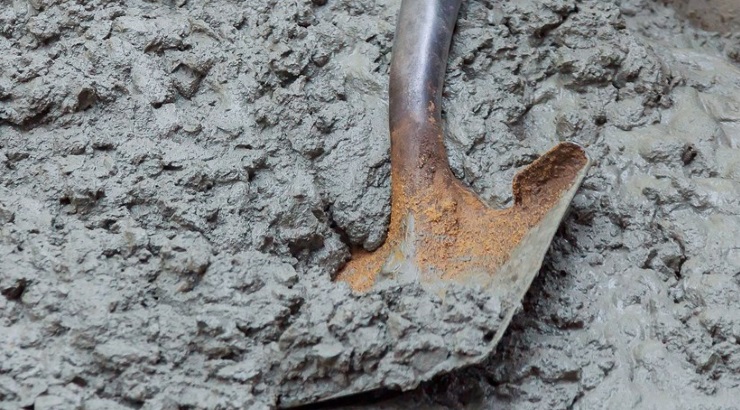Features
5 Types of Concrete Admixtures
A quick overview of the five main classes of concrete admixtures.

Concrete admixtures are chemicals added to concrete mixtures during mixing to create properties that improve the quality of concrete, its usability, acceleration, or deceleration of setting time, among other specific results.
Most concrete admixtures are sold in ready-to-use liquid form and are added to a cementitious mixture, immediately before or after mixing, at the construction site.
What are the types of admixtures in concrete?
Admixtures are classed according to function. There are five distinct classes of chemical admixtures: air-entraining, water-reducing, retarding, accelerating, and plasticizers (superplasticizers).
Let’s discuss each of the five classes in detail.
1. Accelerating admixtures
Accelerating concrete admixtures is used to escalate the rate of concrete strength development or to shorten concrete setting time.
By stepping up the process, a contractor can remove forms much earlier or to get onto a concrete surface ahead of time for finishing.
Accelerating concrete admixtures are commonly used during cold weather. This is due to their ability to counter the effects of low temperatures, which slow down the curing and settling process.
However, these types of chemicals can be used even during warm weather to hasten the curing process.
Calcium chloride is arguably one of the best concrete accelerator components ever. This chemical is, however, no longer a popular option as it causes severe corrosion in steel-reinforced concrete.
Most admixtures in the market today are made using nitrate and thiocyanate, although the two salts are not as effective as calcium chloride.
Nitrate aids the settling of concrete while thiocyanate hardens the material.
2. Retarding admixtures
A retarding concrete admixture is a chemical that delays the compound reaction that occurs when the settling process begins. It works by increasing the time of settling of Portland cement paste and subsequently that of its mixtures.
Retarding concrete admixtures are used during hot weather to counter the effects of high temperature, which quicken the settling process.
These admixtures are commonly used in the construction of concrete pavement as they allow more time for finishing while eliminating cold joints in concrete.
Retarding concrete admixtures can also be used to prevent cracking due to form bending that can occur when horizontal slabs are positioned in sections.
3. Water-reducing admixtures
Water-reducing admixtures are added to concrete to create a desired concrete slump at a lower water-cement ratio than what is the norm.
They reduce the required water content for a concrete mixture by 5 to 10%.
These admixtures are used to gain specific concrete strength using lower cement content. By using lower cement content, a contractor can cut carbon emissions as well as energy usage per volume of concrete generated.
RELATED: How to Check Quality of Cement
Water-reducing admixtures improve the properties of concrete, making it ideal for placing under difficult situations. As such, the admixtures are commonly used in low-slump concrete, bridge decks, and reinforcing concrete.
4. Air-entraining admixtures
Air-entraining admixtures are used to create ultra-stable, small and closely spaced air bubbles to provide concrete with extra protection.
These admixtures improve the durability of concrete when experiencing cyclic freezing and thawing weather.
Air-entraining admixtures work by preventing an increase in internal pressure, which forms cracks during low temperatures.
Air-entraining admixtures can be used together with most types of admixtures.
5. Superplasticizers
Superplasticizers, also known as high-range water reducers or plasticizers are chemicals added to concrete with a low-to-normal slump and water-cement ratio to make high-slump flowing concrete.
They are mainly used to produce flowing concrete with 7 to 9-inch slumps for use in heavily reinforced structures and in situations where sufficient consolidation by vibration is not easily attainable.
Flowing concrete is a highly fluid but workable concrete that can be placed with little or no vibration or compaction.
The effect of superplasticizers lasts only 30 to 60 minutes, depending on the brand and dosage rate, and is followed by a rapid loss in workability.
As a result of the slump loss, superplasticizers are usually added to concrete at the job site.
Specialty admixtures
Concrete admixtures that fall into the specialty category perform various functions such as shrinkage reduction, corrosion inhibition, alkali-silica reactivity reduction, bonding, damp proofing, workability enhancement, and coloring.
RELATED: Types of Cement and their Uses
Shrinkage-reducing concrete admixtures are chemicals used to produce concrete with greatly reduced drying shrinkage and the potential for subsequent cracking.
These admixtures are commonly used in situations where shrinkage cracking could lead to durability problems or where large numbers of shrinkage joints are undesirable for economic or technical reasons.
Corrosion-inhibiting admixtures are used to alleviate corrosion of reinforced steel in concrete due to aggressive chloride exposure conditions. This results in a more durable reinforced concrete structure.
These admixtures work by forming a passivation layer on the steel surface to protect the material against chloride and other salt ion damage.
They also help make concrete less likely to absorb water, thus minimizing the amount of water and dissolved salts that can infiltrate to corrode structural steel.
FAQs
What is a concrete admixture and why is it used?
A concrete admixture is a chemical added to a cementitious mixture, immediately before or after mixing, to improve the quality of concrete, its usability, acceleration, or deceleration of setting time, among other specific results.
What are concrete additives?
Concrete additives, also known as additives of concrete, are special chemicals added to concrete to improve its physical and chemical properties. These components represent a wide array of products with varying chemical properties.
What is the difference between admixtures and additives?
Admixtures are chemicals added to concrete to get new properties for the material, while additives are added to cement during manufacturing to get new properties for the cement.














